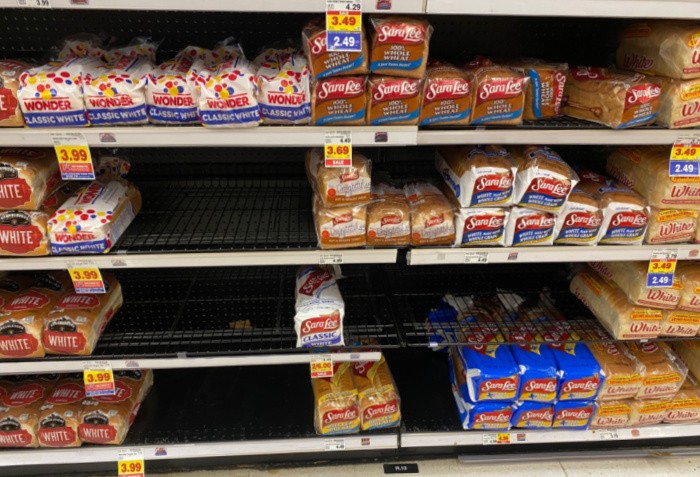
I admit I don’t like grocery store shopping. There, I said it. I like to take pictures and check on prices. Today, I may have to get on my soapbox. We have a problem, my friends. It’s our food chain, the drought around the world, the price of gas to deliver the food, food shortages, higher prices, and the list goes on and on.
Today, I want to talk about some food shortages and the higher prices of the food we like to purchase. I must be honest, and I miss delicious, thick, center-cut bacon. I refuse to cave to the prices. Luckily, we couldn’t have a garden with fresh tomatoes last year for my BLTs, or I may have had a tantrum at the store while looking at the bacon prices. I’m just kidding, but if I were prone to high blood pressure, it would have gone sky-high.
This is the third time this month that I’ve written about possible food shortages you may experience when shopping now or in the near future. Some shortages may be somewhat localized, but others will probably be more universal.
My research has determined that the following items will likely prove harder to get, if not already so in your area. Please read through the information, check out your local stores, and then plan and act according to your family’s food needs when stocking up.
In case you missed these posts, 10 Food Shortages You Need To Stock, or this one, 17 Shocking Things You Didn’t Know About Stocking Food

Grocery Store Shopping
1. Pork
Shortly after the virus issue became global, news reports were full of pictures and stories about farmers and ranchers who were having to destroy thousands of animals because so many meat processing plants had closed. The plants simply couldn’t operate with the reduced labor available. In April 2020, Smithfield Foods, the world’s largest pork producer, shut down a plant in Sioux Falls, SD.
At about the same time, Tyson Foods reported having to shut down its pork processing plant in Waterloo, Iowa. The country quickly found itself in a severe pork shortage, and demand quickly dwindled with the closure of so many restaurants.
We’re four years from those tough times but still deal with some common issues. One key challenge is getting enough quality labor to support the operation of those plants. Another concern is the cost and availability of food for the animals.
Both drought and floods have affected crops in many parts of the country. Some farmers have debated whether to pay higher food costs for their stock or not to replace it since they may not be able to sell the meat at a price to cover costs, let alone make a profit.
The dilemma is exacerbated by the cost of shipping food to those farmers and the animals to slaughterhouses. Then, there is the cost of shipping the finished meat products to stores nationwide. The high cost of diesel fuel is affecting many industries.
Thank goodness the trends for more products are showing positive signs, according to the Pork Trends report from US Foods. Depending on your location and the types of cuts desired, they are seeing some highs and lows. It could be a while before we see more stability across the pork industry.
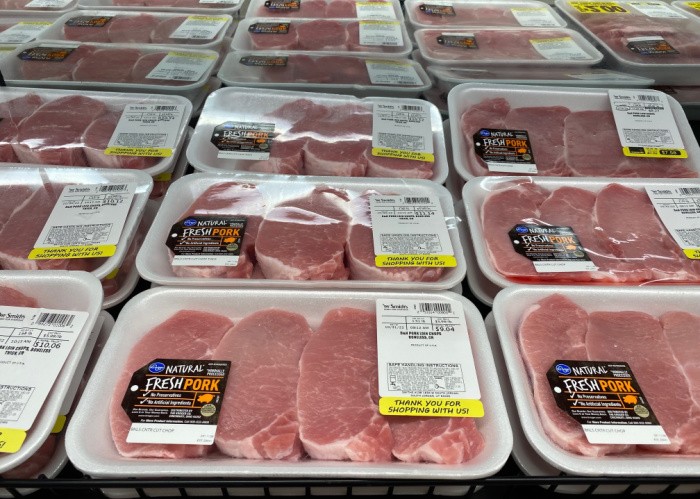
2. Bacon
As discussed above, Bacon faces the same challenges as the general pork industry. Still, the additional processing involved in bacon manufacturing adds to the cost and related effects on our regular food systems. I mentioned the impact of severe drought and floods in the pork industry, but other factors play out, too. The reduced availability of fertilizers for their crops and the higher-than-normal fertilizer prices directly affect the cost of agricultural production, including the food for bacon-producing pigs.
I wanted to bring to the attention of my readers, particularly those living in California, the effects of legislation passed in that state. I wasn’t aware that 99% of California pork consumption comes from pork raised and processed outside the state.
Years ago, their legislature passed Proposition 2, which required certain living conditions for birds and animals raised for food production, particularly how much room each one had to move around. More recently, the legislature passed Proposition 12, which took additional steps to protect those birds and animals so there wouldn’t be any cruel treatment.
Prop 12 extends those requirements to out-of-state providers. Meat producers have fought the legislation, but many animal rights groups have pushed very hard to see it implemented. There has been much dialogue about the proposition’s negative economic impacts, not only in California but also in those states where the birds and animals are being raised and processed.
One of the economists who have weighed in on the issue is Lan Hatamiya, the former Secretary of the California Technology, Trade, and Commerce Agency. He issued a White Paper on the matter and indicated he anticipates a 50% reduction in pork supply, which an independent market expert, Rabobank, supports.
Mr. Hatamiya states: “Market access restrictions from Proposition 12 will further limit available supply into California, thereby driving up pork prices for all consumers. The negative financial burden falls largely on the diverse ethnic consumers and communities that make up California, with pork being an important source of protein for African American, Asian American, and Hispanic households, businesses, and restaurants.”
We need to think about those most adversely affected by this legislation, including those on WIC, others experiencing poverty, and those already challenged by acute food insecurity. Nutrition is an issue, as those facing hunger issues need protein consumption levels just like the rest of the population. I’m not sure about the number of people affected, but it seems the legislation sidesteps many social determinants of health.
Some experts expect retailers to increase the price of retail pork by 50%, and the resulting consumer cutbacks in purchases will reduce by multi-millions of what California consumers spend on bird and pork products annually.

3. Pasta
Pasta, as we know it, is generally made from durum wheat semolina flour and added to a water and salt mixture. The strange thing is that durum wheat has been selling for prices much lower than usual, so the grain isn’t being grown in the quantities seen in years past, with other types of wheat and farm products being grown and harvested in its place.
Due to a shortage of regular pasta, many chefs and restaurants have been forced to substitute other wheat-based versions for their “pasta” entrees and deal with the difference in texture, taste, and consistency.
Those of us at home may not even notice a difference. But if we are purists and want the durum wheat varieties of pasta we’ve enjoyed for years, we’ll have to look for stores that carry those products, with the understanding that we’ll probably pay more for them. Check the stores in your location for availability and buy anything that might go on sale.
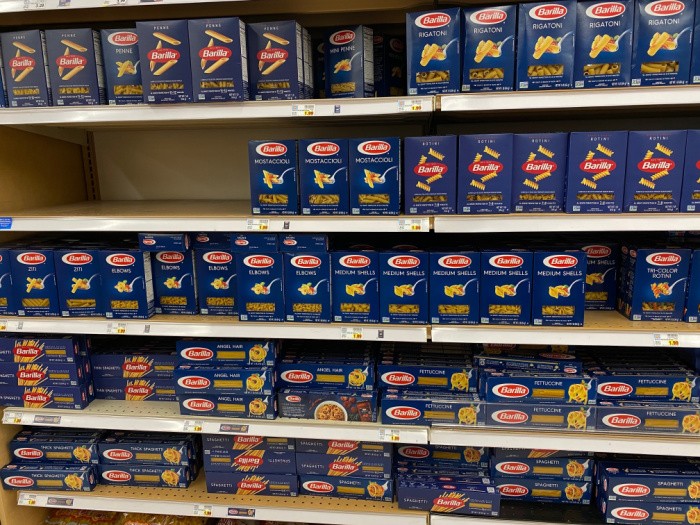
4. Apples
Like other fruits and veggies, apples are grown throughout the U.S., but some states, like Washington, are known for their apple varieties, quality, and high production levels. Also, like other fruits and veggies, climate change and the variations in weather patterns have directly influenced apple production in the past few years.
I read an article this week about a farmer in Versailles, KY, who has had a great apple harvest this year. But he indicated that other areas of KY haven’t been so lucky. He noted that apples can be a little picky and require a specific set of sun, water, and pollination conditions to succeed. Many areas in the country are experiencing drought, so sufficient water has been a challenge, and it doesn’t look like that will change soon.
We’ve all heard about the challenges to the bee industry in the past few years, too. Disease and insecticides have decimated thousands of bee colonies, making pollination of all crops, including apple trees, hard to accomplish. The bees seem to return, but complete production levels may be a few years out.
If you see apples on sale, even if your favorite variety isn’t on display, I’d suggest you buy some so you have what you want for holiday treats over the next couple of months.
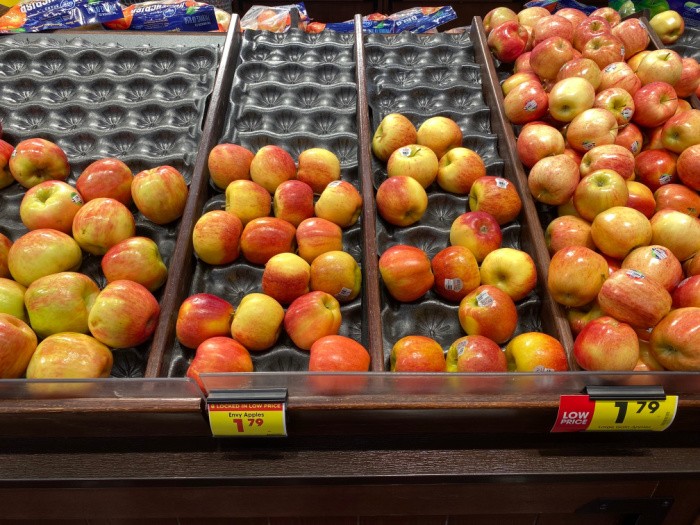
5. Oranges/Lemons
We all love citrus juices to drink and cook with. Most of us realize that much of the citrus production in the U.S. comes from the state of Florida. We’ve seen the devastation in many of the beach areas of western Florida due to Hurricanes Ian and Helene. Still, we may not be aware of the extreme damage to the agricultural areas of Florida, including the trees that grow oranges and lemons.
The U.S. Department of Agriculture has reported that crop production due to the hurricane will plummet to record-low levels this year. Before the hurricanes, the state already dealt with weak citrus production levels. Florida oranges have long served as feedstock for most orange juice produced in the U.S. That feedstock has been diminished significantly by greening disease in the past few years. The disease can cause the trees to generate fruit that is not only smaller but also less sugar-laden.
With the combination of Hurricane Ian and Helene’s greening disease, the USDA forecasts that 12 million boxes of Florida oranges will be produced during the 2025 growing season, a decrease of 33% forecast in December 2024. That is the lowest production output of oranges since 1943, significantly lower than last year’s already low production level of 41 million boxes.
Add that to the lower production expected from California-based orchards due to the western states’ drought, and we are looking at a “perfect storm.”
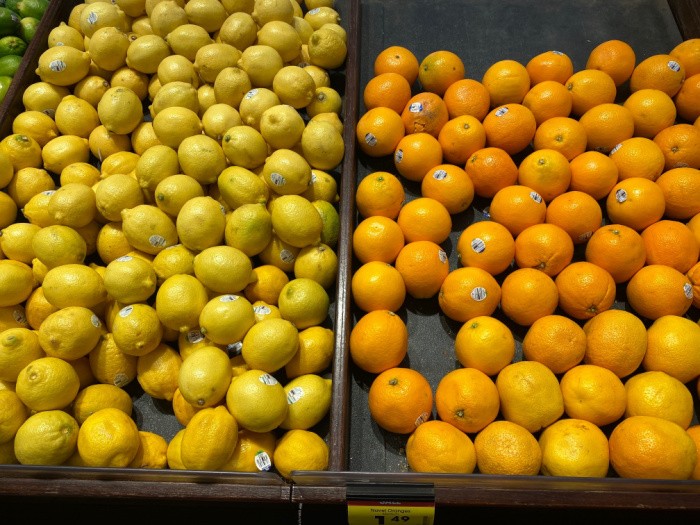
Orange Juice
Two additional considerations that influence the cost and availability of orange juice from a limited orange crop this year will be the cost of the plastic containers the juice comes in and the cost of distribution. Due to supply chain issues, the woes we are all experiencing carry over to packaged food and drink products. We haven’t even covered the cost of labor shortages in all industries. Fewer employees but increased labor costs are affecting companies across the board.
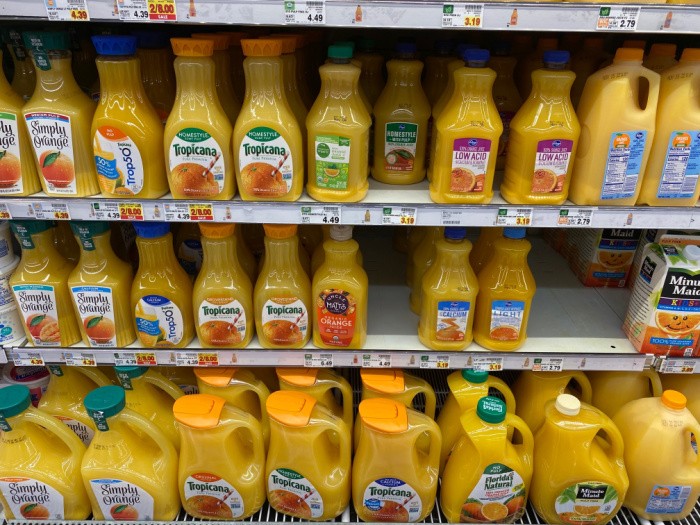
6. Bread
We’ve talked about the increases in the cost to produce many agricultural products due to unfavorable weather conditions, shortfalls in available fertilizer, transportation and fuel costs, labor shortages, and more. The U.S. and other countries had already been seeing challenges in production before the virus issue, but now, with the conflict in Eastern Europe between Russia and Ukraine, those challenges have been compounded.
This is especially the case with wheat production. A year ago, Bloomberg indicated that U.S. government forecasts for global wheat reserves were down to a five-year low, creating a global deficit. Since wheat is considered a food “staple,” food price inflation is a given. Higher wheat prices lead to higher flour prices, the key ingredient of bread and bread-related products.

7. Donuts
Since donuts are made from wheat flour, the same issues apply to them as the ones discussed above regarding bread.
During my research, I found an interesting discussion about shortages of various varieties of donuts at Dunkin’ Donuts locations, particularly in certain eastern states. It related more to the type of glaze or fruit fillings that weren’t available, making the donut run during the holidays a new adventure. Check out the piece on Mashed.com
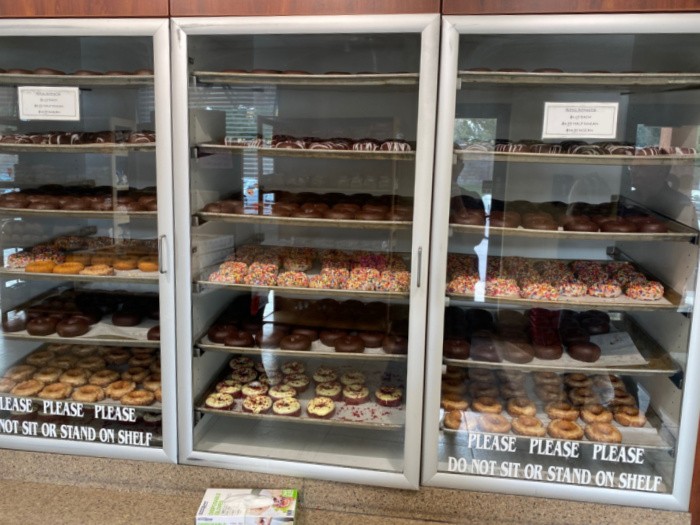
8. Steak
Many beef shortages and related price increases mirror what we discussed above with the supply of pork products. The shortages were often due to challenges resulting from the widespread virus. Those included layoffs, plant closings, disputes about getting the needed shots, cutbacks in feedstock animals, costs of raising those animals, distribution costs and labor shortages, and more.
Now that we are returning to a more “normal” situation regarding food supplies, costs don’t seem to be coming back in line as we anticipated. One thing that is happening, particularly at this time of year, is an increased demand due to all the holiday cooking, whether at home or with restaurant visits. People try to be more social and get together more often, either with home-centered parties or fancy get-togethers at favorite eating establishments.
One thing I recently heard about was an increase in businesses victimized by cyber-hacking. That was the case at JBS USA, a huge beef processing company headquartered in Greeley, CO. Yes, we all rely on computers every day to accomplish personal and business goals. When those attacks hit a company like JBS USA, it can cause numerous plants to close until their computer systems are up and running again.
If you love beef steaks, consider checking into the availability of buying your meat directly from a local rancher. You might find some savings in price, but you also can often get custom butchering services so the cuts of meat match your size and quality desires
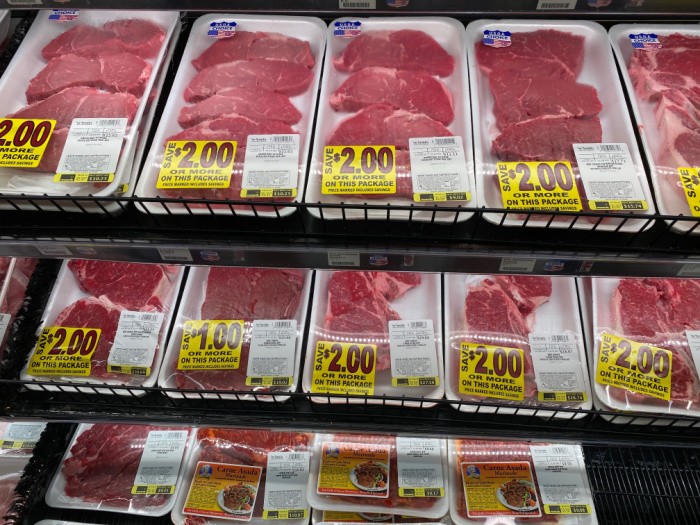
9. Ground Beef
The discussion here would mirror the dialogue above for steak. One aspect of ground beef that adds to the mix is the extra time it takes to process the meat. Yes, ground beef usually doesn’t require the highest-quality cuts, but it does take time to run it through the machinery, adding to labor and equipment expenses.
Again, if you buy from a local rancher, you may be able to get better-quality cuts, which will actually make the ground beef a better per-pound option.
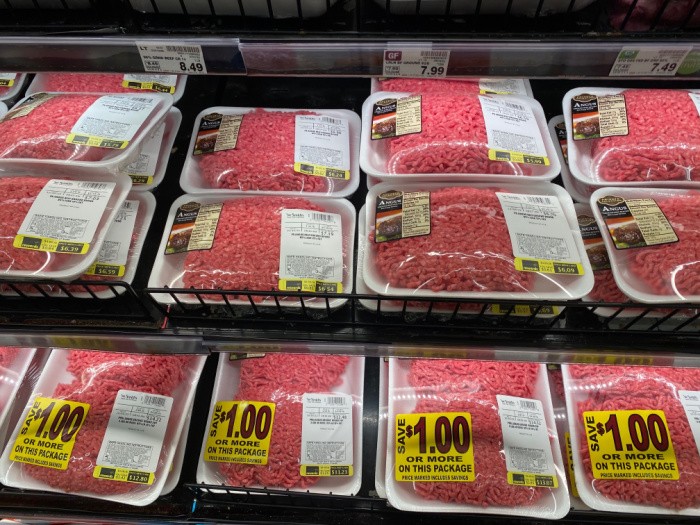
10. Chicken
Much like the issues with pork and beef, market conditions have also affected chicken. Tom Super, who belongs to the National Chicken Council, has indicated that factors like high demand, particularly with more families cooking at home, record expenses in the raising, processing, and distribution of chickens and their food products, and extended labor shortages at the plant level have all influenced the availability and pricing of chicken at the retail level.
You’d think we could acquire more chicken products from foreign sources, but the supply chain bottlenecks make that a risky option. I would much rather purchase meat right here in the USA.
Also, the Proposition 12 issues discussed above regarding pork apply to chickens being processed and shipped to California. Don’t be surprised if you see the pricing of all chicken products continue to increase.
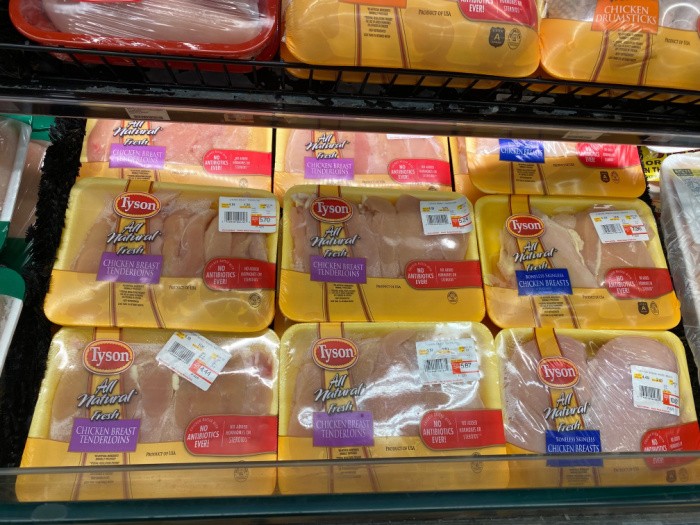
11. Breakfast Cereal
Cereal has proven to be subject to shortages, just like other products tied directly to the agricultural sector. Many kinds of cereal are made from wheat, but other farm products like oats, rice, barley, corn, etc., also come into play. The last year has also been filled with labor issues, as illustrated by the strike at Kellogg. That company was able to mitigate some of the shortages until a settlement was negotiated when they went offshore for the needed commodities.
Weather, manufacturing costs, transportation expenses, and local demand for specific cereal types will determine cereal shortages and related product pricing going forward.
Mark went to Walmart yesterday and bought close to $100 for a multi-month supply of his favorite cereal brands and flavors. He’s found that from time to time, one product seems to disappear from store shelves. No, he didn’t hoard the cereal. He bought the larger, more expensive packages since the cost per ounce is less. He did see some empty shelves, but all his favorites were available.
Hopefully, next year’s growing season won’t be adversely affected by the lousy weather patterns we’ve seen in the past few years. Otherwise, it won’t be just cereal found wanting from the farmers’ fields.
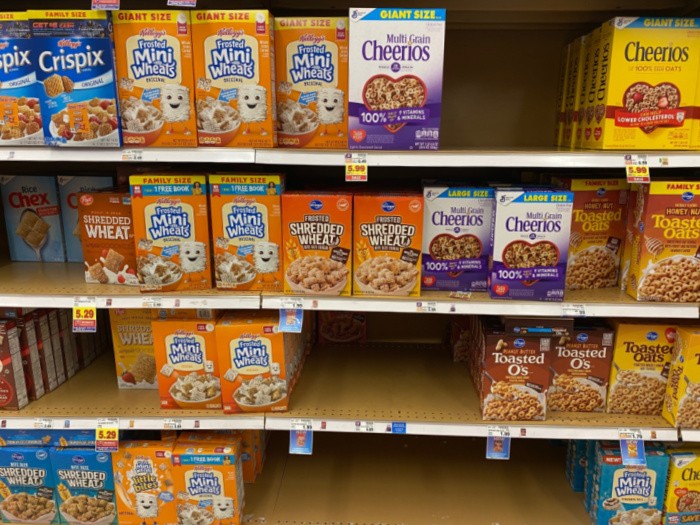
12. Personal Hygiene Products
In an earlier post, we discussed shortages of women’s monthly hygiene products. Additional research has determined that the increasing costs of paper and plastic materials to make and package them have both gone up. Bloomberg reported that tampon prices have gone up 9.8%, and menstrual pad pricing has increased 8.3% over the past year.
Procter & Gamble is one of the primary manufacturers of these products, claiming to have nearly 50% of the market. They haven’t commented about shortages or cost changes but indicated that their demand has significantly increased. They are working to step up production and hope things will stabilize soon.
A spokesperson for Resilinc, a supply chain monitoring company, indicated that there are still challenges with the supply of key materials to make these products. From the effort to find raw materials, getting those products to the manufacturing plants, the workers to run the plants, and then on the trucks for delivery to the stores, each step is seeing issues of cost and availability.
Those of you who are willing to try them might want to consider making reusable menstrual cloth pads that can be washed and reused. They may not be as comfortable or convenient, but they are an alternative that will keep you protected and save you money. Homemade Menstrual Pads
There have been reports of shortages and price increases for personal hygiene products like bars of soap and liquid hand soap. Walmart even posted apologetic signs in many of their stores regarding shortages, even though the shelves where the signs were posted had full shelves.
Apparently, packaging and distribution issues did prompt some concern, but there also appears to have been some increase in purchases as people tried to stock up “just in case.” Another issue is the increased use of these products since we were all asked to wash our hands more often as protection against the virus. Things seem to have stabilized, but you might want extra on hand as a hedge against possible future price increases.
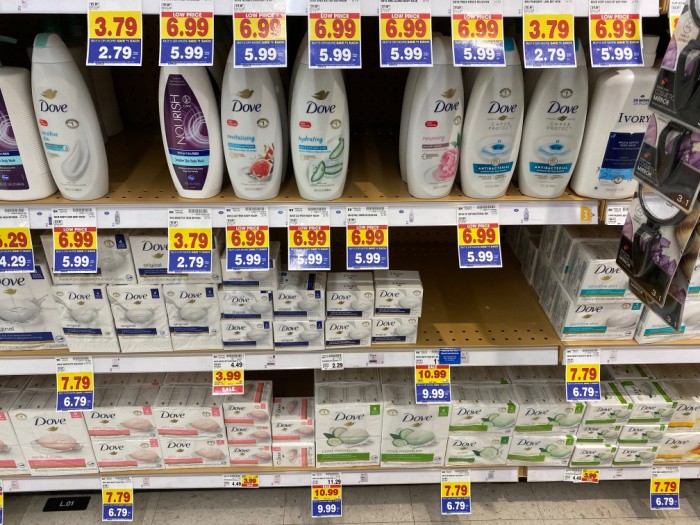
13. Paper Products
Although not as severe, there is still a shortage of paper products. The Phoenix Group of Companies reported that coated and uncoated papers were in short supply at manufacturers, wholesalers, marketing companies, and print shops nationwide. Much of the original shortages were due to lockdowns across the industry and the continued supply chain issues affecting most industries.
Online shopping trends have also added to the shortage challenge. With the increased demand for packaging, many mills have shifted production from regular paper products to paper packaging, cardboard, kraft supplies, and other materials needed by Amazon and other online retail outlets. If you’ve ordered anything of significant size online, you know what I mean.
There have also been some paper mill strikes in countries like Finland, where much of our paper is milled before being shipped to the U.S. The Russia-Ukraine conflict has also contributed to supply chain blockages and increased gas and freight costs to get products to plants and markets.
There has been a recent shift back to regular paper production from some domestic mills that had moved towards packaging production, but that will take some time. Many mills are still reluctant to make any major changes in either direction due to the enormous cost of machinery required to support such a move. Over the next few months, we’ll see how well new production sources come online to support the demand for paper products of all kinds.
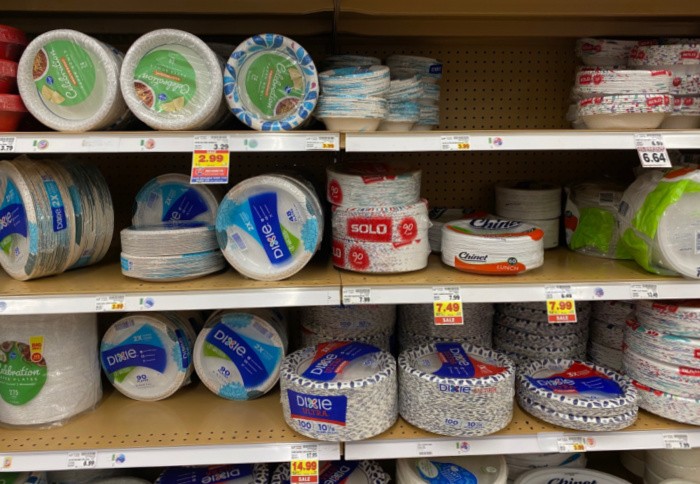
14. Yogurt
In another recent post, we discussed the possible shortage of many dairy products. Those shortages are partly due to the shift from dairy production prompted by many consumers moving away from dairy to more fruits and veggies, a drop in plant production. Add to that the increased cost to produce dairy products, the cost of feed for the cows, the cost of labor to draw workers back into the workforce, the cost of transportation of the milk to processing sites and then to retailers, and more.
An additional challenge to the mix, particularly regarding yogurt, is the fruit generally added to the yogurt for flavor, color, and nutritional value. As mentioned, many fruits will be hard to supply because of weather challenges that may stem from floods, drought, or extreme heat and cold from climate change.
Add to that the challenges of acquiring the raw materials for plastic containers and other packaging materials, the distribution channel bottlenecks, labor shortages, and other market forces that make for smooth processes from farm to table.
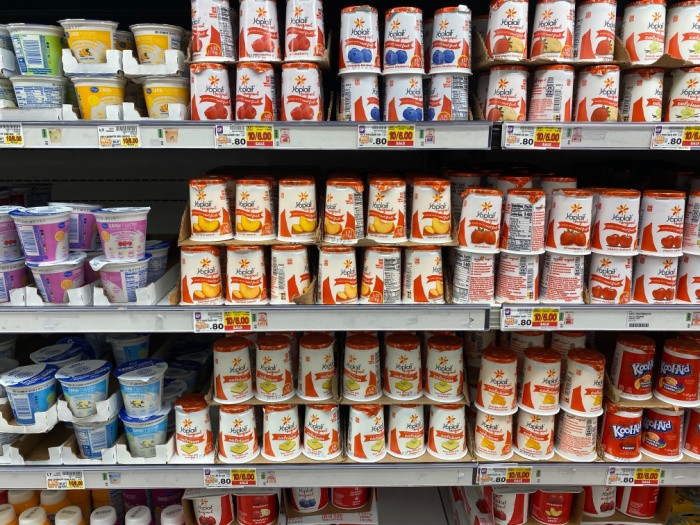
Final Word
I’m sure we are tired of hearing about the shortages of so many products we take for granted. Many markets and world events have come together to cause the shortages, so it’s hard to estimate when we may see things at a level we feel more comfortable with.
Shortages are frustrating, but the current costs for things of all kinds are making it hard for millions of families to make ends meet while trying to provide a healthy and safe environment for members of each household. When I shop with Mark, I don’t know how young families with kids can provide the necessities of life with the cost of living where it is right now. Hunger can be a scary prospect if funds are limited, particularly if we have young kids and infants.
I’ve always suggested to my readers that they should consider a garden to at least help offset the high cost of fresh vegetables we all love to eat. We should also have a plan to stock up on food, water, and other critical things to better survive during trying times. My favorite place to buy my garden seeds is SeedsNow. I highly recommend you stock quality seeds and learn to save them for the following year.
Thanks for your continued support by visiting my site and reading my posts. Let me know if you’ve experienced any shortages I haven’t outlined so I can pass that info on to others. May God bless this world. Linda
The post Grocery Store Shopping appeared first on Food Storage Moms.
from Food Storage Moms
No comments:
Post a Comment